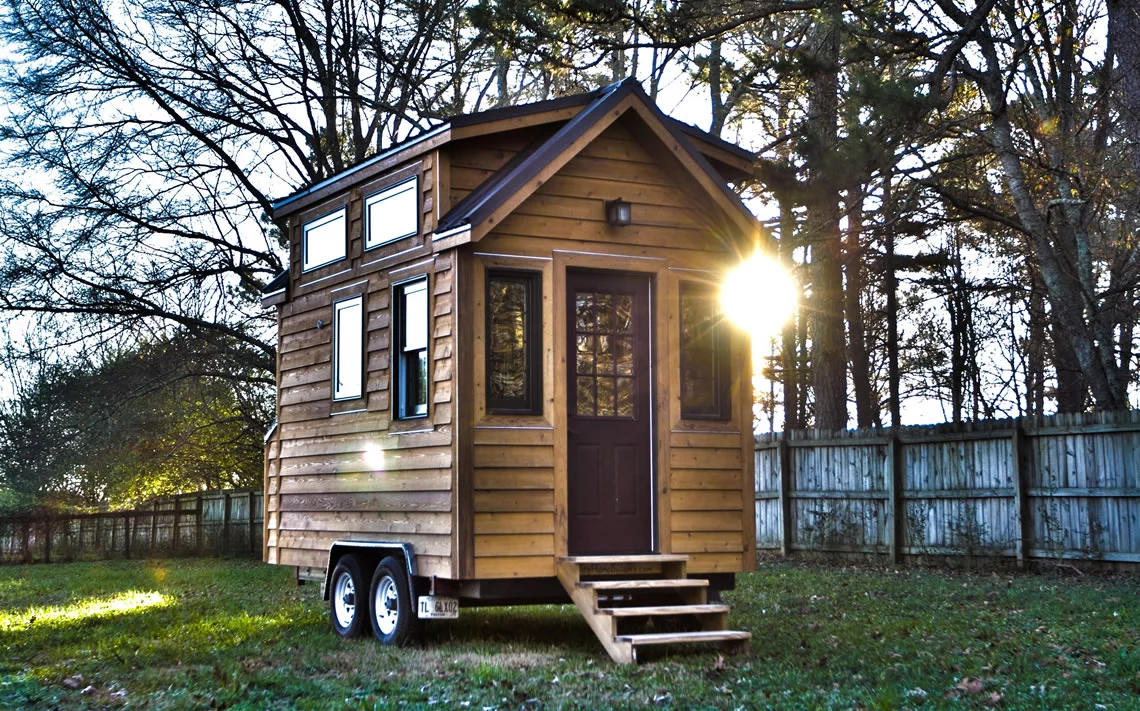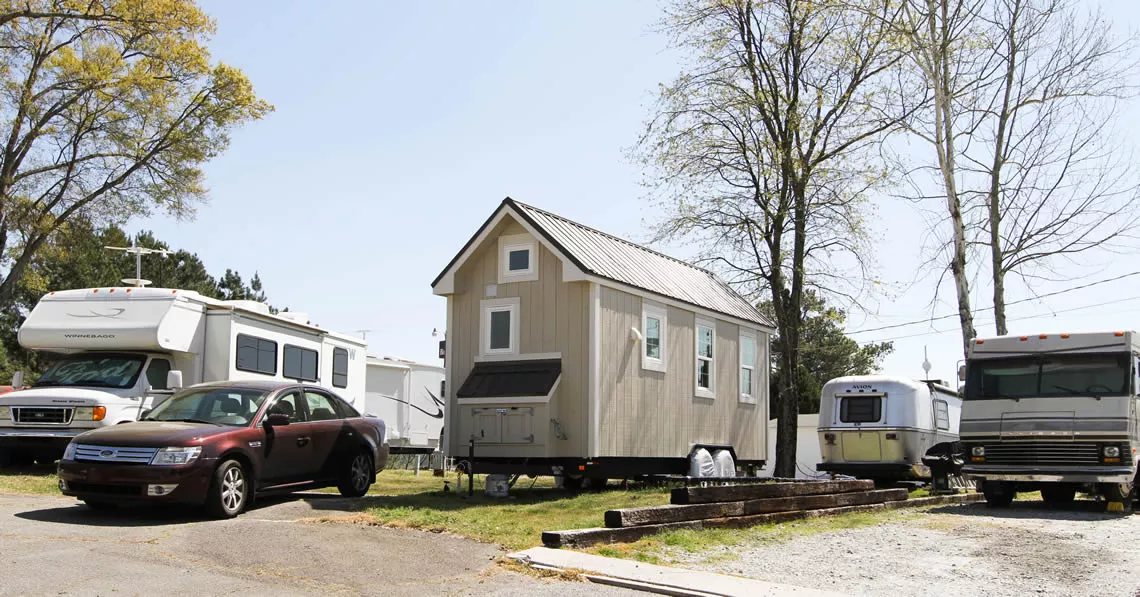What is a Tiny House?
While there is no official definition of a tiny house, it is generally thought of as a small house, typically sized under 600 square feet. While they can be built on foundations, most tiny homes are built on trailers. This style of tiny house is often referred to as a THOW (tiny house on wheels).
There are several advantages to building a tiny house on a trailer. The two most favorable being, mobility and getting around local rules that dictate minimum structure size. Since a house built on a trailer is not on a permanent foundation, it normally is not governed by local building codes. Many municipalities dictate a minimum home size (square footage), which makes building a tiny house on a foundation not legally possible.
There are however disadvantages to building a house on a trailer. The main one being that it is confined to strict dimensions, since it will be driven down the road. The maximum dimensions allowed, without obtaining a special permit, are 8 feet 6 inches wide, 13 feet 6 inches tall, and 40 feet long. While this is the maximum, it is rare to see tiny houses longer than 32 feet, since beyond that length they become much more difficult to transport. For more information about transporting a tiny house be sure to read our Tiny House Towing Guide.

Tiny Home Builders - Tiny Living 12
What is the Tiny House Movement?
The Tiny House Movement is an architectural and social movement that encourages living a simpler life in a smaller space. People from all walks of life have determined that a large home, and more specifically, the large cost of living that comes with it, is both unnecessary and a detriment to their happiness. These people have turned to tiny house living to reduce the financial and emotional burden of STUFF.
A large percentage of people involved in the tiny house movement are DIY’ers, meaning people who are interested in building their own homes. It is incredibly empowering and fulfilling to construct your own home from the ground up. With that said, as the tiny house movement becomes more mainstream, more companies are trying to capitalize on the increased demand by offering pre-built and custom homes.
Why People are Going Tiny
Over the years we’ve talked to tens of thousands of people who are looking to transition to the tiny life. And while their individual circumstances may vary considerably, their motivation for wanting change normally falls into three different groups.
Financial Benefits
The financial benefits of a tiny house are considerable. The most obvious savings are with the initial cost of the home. A tiny house can be built for less than the cost of most cars. And because they are built to the same quality of conventional homes, they can be expected to have a similar lifespan. Despite their lower cost, a properly built tiny house can provide housing for decades.
Once a home is built, the savings don’t stop. Because of their smaller size, most of the utilities and all the maintenance costs are less as well. While there is no savings to some bills like cable TV or garbage pickup, there are considerable saving to others, like electrical and gas. For example, my mom’s electrical bill for her tiny house in Florida was only $25 a month.
Additional savings are had with reduced property taxes or rent. Since tiny houses are not permanent, they are not considered an improvement to land, and thus don’t add to the value of the land or the expense of the property taxes. If the land is rented and not owned, it is also considerably cheaper to rent a plot of land versus a house or apartment.
Finally, there are also financial benefits from the reduced consumption that results from living in a tiny house. Having less space results in less shopping and buying. There simply isn’t the room for frivolous purchases, and so a shift occurs where shopping loses its appeal. This actually has many benefits beyond economical.
Simplification
There is no need to move into a tiny house if simplifying your life is your goal. There are techniques that can be used to simplify now, thus there is no need to wait. While this is true, a tiny house will force you to lead a simpler life.
Living tiny results in owning less. With that comes less thinking about your stuff, less time upgrading your stuff, less time maintaining your stuff, you get the picture. This process is so common that we’ve stopped noticing it and just consider it part of life. It is an invisible weight on our shoulders. Only after it is removed do we recognize that it even existed. When I talk to people that have moved into tiny homes, I am repeatedly told how surprised they are that something they didn’t even know existed was having such a big impact on them.
Financial reasons are what brings most people to the tiny house movement, but the simpler life is what keeps them in it.
Environmental Benefits
Using fewer utilities not only saves money, but it also has a smaller impact on the environment. Some homes go so far as to use no utilities by being completely off-grid. Also, with less consumption comes less waste going into landfills.
Challenges of Going Tiny
While there are significant advantages and benefits of joining the tiny house movement, there are also challenges that need to be overcome before you take the plunge.
Where to Park your Tiny House
Probably the biggest challenge that people face with transitioning to a tiny house is finding a legal place to put their home. Codes and laws change from state to state, county to county, and even city to city. This doesn’t make it easy to just pull in and say, “I am going to buy this property and place my tiny house on it and live carefree!” Many places will tell you that you cannot live in a vehicle on the property for more than 30 consecutive days (because they consider the tiny house an RV). To learn more about successfully parking your tiny house check out our Tiny House Parking Guide.

A tiny house in an RV park
Financing and Insurance
Financing and insurance can be a challenge as well. Financing and insurance companies rely on having accurate values for the items they finance and insure, and with tiny houses those values aren’t always reliable or clear. For instance, if an individual built their own house and did so incorrectly, their structure could potentially be worthless.
As the demand for tiny houses grows and the market becomes more mature, we are seeing more and more companies willing to take the risk with tiny houses. There are now big companies offering financing and insurance for them.
Who's Joining the Tiny House Movement?
While anyone can benefit from the advantages of living tiny, we primarily see two groups that are most interested; younger individuals or couples that do not have children, and those entering retirement.
There are many reasons younger people are more interested in tiny houses. There is risk associated with moving into a tiny house as highlighted above, and the uncertainty of having a permanent spot for your home can be emotionally challenging for anyone. But it is less of a concern for younger individuals who can be more flexible and make faster lifestyle changes. Changes, such as moving, become increasingly difficult the more roots you have down, for example having children in school.
Younger people have also had less time to acquire more belongings, so that idea of minimizing is less impactful. People tend to fill the space they are in, and if you have not yet lived in a home on your own, you likely won’t have as much stuff as someone who has.
Those entering retirement are also more interested in tiny houses. As we age and look to spend less time working, our bills unfortunately don’t change because of our desires. To cover those bills and our cost of living, we either need to have adequate savings or reduce our cost of living to a sustainable level. Unfortunately, many don’t have the needed savings and are thus looking to the alternative. As previously outlined, one way to dramatically decease that cost of living is to go tiny. The biggest roadblock to retired individuals moving into a tiny house is the uncertainty of a permanent living location. No one in retirement wants to be told they must move and go through the challenges of finding a new location for their home.
As you may have noticed, these two groups exclude families. While some families do indeed live in tiny houses, it is not as common. The challenges around having the room for the stuff people typically associate with having children, as well as privacy and personal space limitations, is too much for many to take on.
Tiny House Movement Growth
Tiny houses have always been around in some form. Mostly people just called them houses back when all houses were tiny. But as homes became increasingly larger our definition and concept of home changed.
In 1999, Jay Shafer built one of the first tiny houses on a trailer and jump started the modern tiny house movement. While interest grew steadily over time it wasn’t until 2014 that the movement went mainstream. That was the year the show ‘Tiny House Nation’ first aired and the term ‘Tiny House’ entered most people’s vocabulary.

Trend for "tiny house" searches
To learn more about the movement’s growth over time, check out The Growth of the Tiny House Movement.
Learn More and Get Involved
Tiny house supporters are gathering in groups, starting organizations, and talking to the powers that be. You will be hard-pressed to find a more passionate group of people than the tiny house community. That is why this is more than a fad, more than a trend, it is truly a movement. Rarely, if ever, have you heard of people coming together on a national level to fight for other real estate trends. And the media is onboard. Reality shows on television, articles in every major magazine and on every major website as well as more news articles arriving daily.
If you are considering transitioning to tiny living, look in your local area (or where you hope to live), and see if a group already exists. This can be a great resource to find out what is allowed, and what is being pushed for locally. One resource to find local groups is the Tiny House Map [tinyhousemap.com] or by searching the web for ‘tiny house’ and your cities name. There is no need to reinvent the wheel and more can always be accomplished by a group than an individual.
If you are still unsure if the tiny house movement is for you, check out Five Tiny House Questions to Ask Yourself Before Going Tiny and 5 Signs You Are Not Ready To Go Tiny